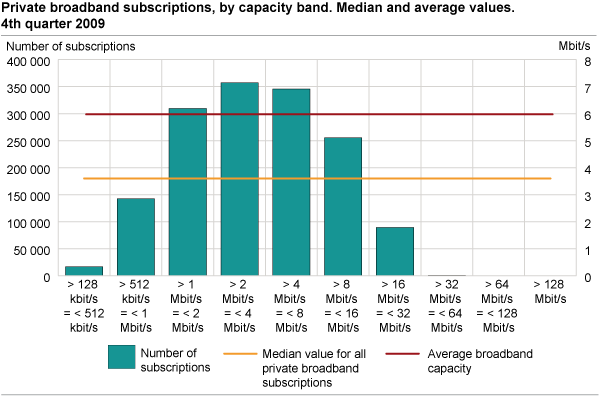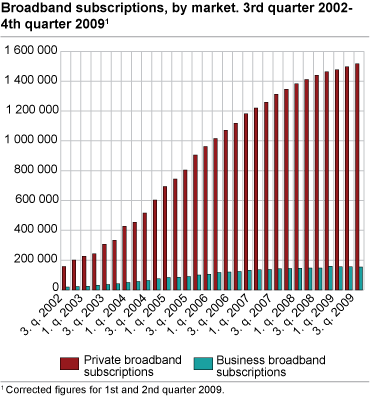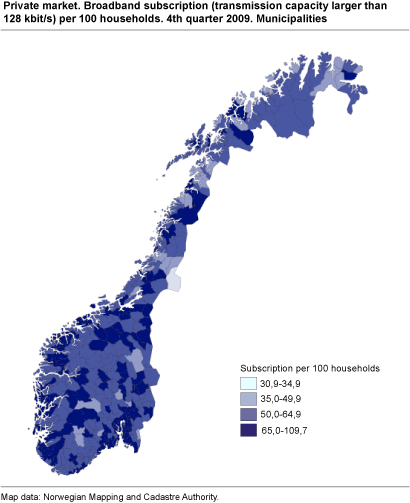Content
Published:
This is an archived release.
Steady growth in fixed broadband access
The annual growth rate in the number of fixed broadband subscriptions was 5 per cent in the 4th quarter of 2009. The average broadband capacity for private subscriptions increased to 5.9 Mbit/s.
The number of broadband subscriptions with fixed access on the Norwegian mainland was 1 671 000 at the end of the 4th quarter of 2009; an increase of 83 000 subscriptions in the last 12 months. Compared to the previous quarter, there is an increase of 19 000 subscriptions. At the end of the 4th quarter, Norway had 1 517 000 fixed private broadband subscriptions and 154 000 business subscriptions.
Increased growth of high capacity private access
Private broadband subscriptions with a capacity of more than 8 Mbit/s total 23 per cent; an increase from 21 per cent in the previous quarter. Only 11 per cent of business broadband subscriptions have this capacity; an increase from 6 per cent in the previous quarter.
The average capacity has increased to 5.9 from 5.7 Mbit/s in the previous quarter. At the same time, the median value has increased slightly, to 3.6 Mbit/s compared to 3.5 in the previous quarter.
Steady growth in fixed broadband subscriptions related to households
The broadband penetration rate in private households increased to 71 per cent from 70 per cent in the last quarter. The figure for private broadband subscriptions per 100 households varies between 77 per cent in the county of Sør-Trøndelag and 59 per cent in the county of Finnmark.
| Centrality1 | Broadband subscriptions | Broadband subscriptions as a percentage of households | |||||||||||||||||||||||||||||||||||||||||||||||||||||||||||||||||||||||||||||
|---|---|---|---|---|---|---|---|---|---|---|---|---|---|---|---|---|---|---|---|---|---|---|---|---|---|---|---|---|---|---|---|---|---|---|---|---|---|---|---|---|---|---|---|---|---|---|---|---|---|---|---|---|---|---|---|---|---|---|---|---|---|---|---|---|---|---|---|---|---|---|---|---|---|---|---|---|---|---|---|
| Remote municipalities | 120 587 | 61 | |||||||||||||||||||||||||||||||||||||||||||||||||||||||||||||||||||||||||||||
| Fairly remote municipalities | 83 343 | 66 | |||||||||||||||||||||||||||||||||||||||||||||||||||||||||||||||||||||||||||||
| Fairly central municipalities | 248 952 | 69 | |||||||||||||||||||||||||||||||||||||||||||||||||||||||||||||||||||||||||||||
| Central municipalities | 1 063 694 | 73 | |||||||||||||||||||||||||||||||||||||||||||||||||||||||||||||||||||||||||||||
| 1 | 1 Centrality 2008, Municipalities 2008. |
The most central municipalities have the highest number of broadband subscriptions relative to the number of households. While the number of broadband subscriptions relative to the number of households is 73 per cent, the corresponding figure for less central municipalities is 61 per cent.
In some municipalities the number of leisure time cottages is high compared to the number of ordinary households. As the number of fixed broadband subscriptions to these cottages increase the figure for subscriptions relative to the number of households may become extremely high. The municipality Bykle is the first to break the threshold of more than 1 subscription per household.
| Municipalities | Broadband subscriptions as a percentage of households | ||||||||||||||||||||||||||||||||||||||||||||||||||||||||||||||||||||||||||||||
|---|---|---|---|---|---|---|---|---|---|---|---|---|---|---|---|---|---|---|---|---|---|---|---|---|---|---|---|---|---|---|---|---|---|---|---|---|---|---|---|---|---|---|---|---|---|---|---|---|---|---|---|---|---|---|---|---|---|---|---|---|---|---|---|---|---|---|---|---|---|---|---|---|---|---|---|---|---|---|---|
| $Average for all municipalities | 70.8 | ||||||||||||||||||||||||||||||||||||||||||||||||||||||||||||||||||||||||||||||
| 0941 Bykle | 109.7 | ||||||||||||||||||||||||||||||||||||||||||||||||||||||||||||||||||||||||||||||
| 0215 Frogn | 89.8 | ||||||||||||||||||||||||||||||||||||||||||||||||||||||||||||||||||||||||||||||
| 1252 Modalen | 88.6 | ||||||||||||||||||||||||||||||||||||||||||||||||||||||||||||||||||||||||||||||
| 1121 Time | 87.3 | ||||||||||||||||||||||||||||||||||||||||||||||||||||||||||||||||||||||||||||||
| 1232 Eidfjord | 85.7 | ||||||||||||||||||||||||||||||||||||||||||||||||||||||||||||||||||||||||||||||
| 1742 Grong | 85.5 | ||||||||||||||||||||||||||||||||||||||||||||||||||||||||||||||||||||||||||||||
| 1640 Røros | 85.2 | ||||||||||||||||||||||||||||||||||||||||||||||||||||||||||||||||||||||||||||||
| 1018 Søgne | 84.6 | ||||||||||||||||||||||||||||||||||||||||||||||||||||||||||||||||||||||||||||||
| 1046 Sirdal | 83.5 | ||||||||||||||||||||||||||||||||||||||||||||||||||||||||||||||||||||||||||||||
| 0213 Ski | 83.2 | ||||||||||||||||||||||||||||||||||||||||||||||||||||||||||||||||||||||||||||||
| 0217 Oppegård | 83.1 | ||||||||||||||||||||||||||||||||||||||||||||||||||||||||||||||||||||||||||||||
| 1151 Utsira | 83.1 | ||||||||||||||||||||||||||||||||||||||||||||||||||||||||||||||||||||||||||||||
| 0926 Lillesand | 82.9 | ||||||||||||||||||||||||||||||||||||||||||||||||||||||||||||||||||||||||||||||
| 1601 Trondheim | 82.9 | ||||||||||||||||||||||||||||||||||||||||||||||||||||||||||||||||||||||||||||||
| 0521 øyer | 82.6 | ||||||||||||||||||||||||||||||||||||||||||||||||||||||||||||||||||||||||||||||
| 1528 Sykkylven | 82.6 | ||||||||||||||||||||||||||||||||||||||||||||||||||||||||||||||||||||||||||||||
| 1563 Sunndal | 82.3 | ||||||||||||||||||||||||||||||||||||||||||||||||||||||||||||||||||||||||||||||
| 1264 Austrheim | 80.6 | ||||||||||||||||||||||||||||||||||||||||||||||||||||||||||||||||||||||||||||||
| 0701 Horten | 80.5 | ||||||||||||||||||||||||||||||||||||||||||||||||||||||||||||||||||||||||||||||
| 0702 Holmestrand | 80.5 | ||||||||||||||||||||||||||||||||||||||||||||||||||||||||||||||||||||||||||||||
| 1246 Fjell | 80.4 | ||||||||||||||||||||||||||||||||||||||||||||||||||||||||||||||||||||||||||||||
| 1804 Bodø | 80.4 | ||||||||||||||||||||||||||||||||||||||||||||||||||||||||||||||||||||||||||||||
About calculation of median and averageMedian value is the value that divides the population in two equal parts -those with higher and those with lower values. In the calculation of the median value it is postulated that the subscriptions in the capacity band of 2-4 Mbit/s divide themselves evenly on all values in this group. In the calculation of averages it is postulated that the subscriptions also divide themselves evenly in all the other groups. |
|
The mobile broadband access was removed because this part of the statistics is not complete and because these subscriptions cannot be distributed geographically and by download capacity in the same way as the fixed access subscriptions. The Norwegian Post and Telecommunications Authority also compiles statistics on these mobile subscriptions but without information about the geographical location or download capacity. The number of Internet service providers reporting to this survey has been around 200 over the past two years. Market changes have reduced this number to 187 this quarter. A few small, but locally important Internet service providers, mostly cable TV providers, are still not included in the survey. Efforts have been made to include these providers. Some small errors related to the distribution of subscribers between municipalities may occur. This can have major consequences for the figures per household for some municipalities. The number of households for 2009 has been used in these statistics. Individuals and businesses can have several Internet subscriptions and several individuals can use the same subscription. The number of subscriptions is therefore not equivalent to the number of households/businesses with Internet access. A household can for instance get Internet access through an employer, educational institution or by sharing access with other households. The survey ICT in households provides more information about households with at least one member under the age of 75 with Internet access. For more information, see About the statistics . |
Tables:
- Table 1 Private broadband subscriptions. Subscription by transmission capacity and county including Svalbard. 4th quarter of 2009
- Table 2 Business broadband subscriptions. Subscription by transmission capacity and county including Svalbard. 4th quarter of 2009
- Table 3 Development features. Broadband subscription by market. Active subscriptions only. The whole country without Svalbard
- Table 4 Broadband subscriptions (larger than 128 kbit/s). Business and private subscriptions. 4th quarter 2009. Municipality
Contact
-
Statistics Norway's Information Centre
E-mail: informasjon@ssb.no
tel.: (+47) 21 09 46 42



